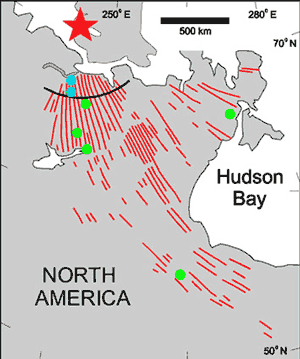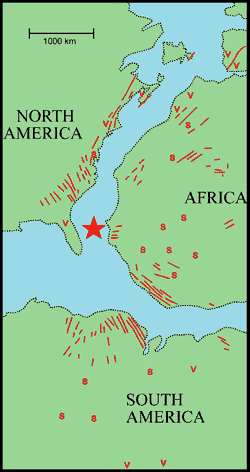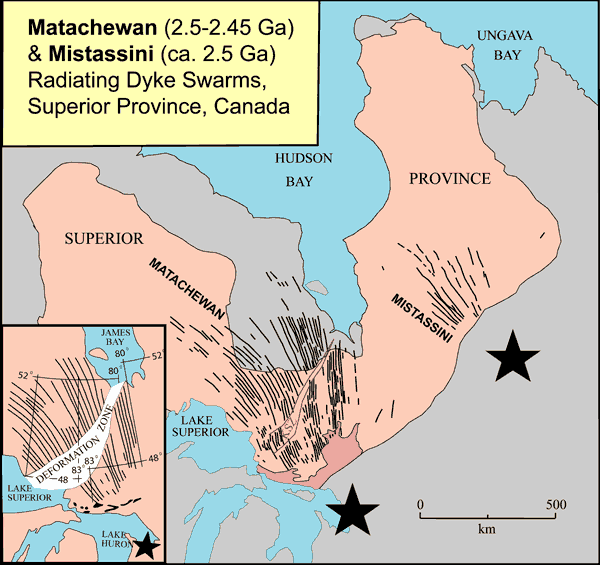 |
 |
Characteristics
and Origin of Giant Radiating Dyke Swarms
|
 |
|
| |
| This contribution
introduces giant radiating dyke swarms to the plume
vs. “alternatives” debate. I briefly review
characteristics of giant radiating swarms on Earth,
Venus and Mars, and discuss constraints on their origins. |
Giant Radiating Dyke
Swarms on Earth
Giant swarms (≥ 300 km in length)
have linear, radiating and arcuate distributions (Halls,
1982; Fahrig, 1987; Ernst et al.,
1997; Ernst et al., 2001). Linear swarms
may be related to rifting, and arcuate swarms may
reflect regional variation in the stress field during
emplacement, or subsequent deformation. I focus herein
on radiating swarms. While some radiating swarms have
a pattern in which dykes trend along the arms of a
triple junction (type 3 radiating swarms; Ernst
& Buchan, 1997), I discuss those having a
continuous or semi-continuous fan of dykes (types
1 and 2). Some dramatic examples are shown in Figures
1a-d. Giant radiating dyke swarms are interpreted
to represent the plumbing system part of large igneous
provinces (Ernst & Buchan, 1997).

Figure 1a: 1267 Ma Mackenzie radiating
swarm, of northern Canada (after Baragar et
al., 1996). Dots indicate areas where flow
direction was determined. Arcuate line indicates
boundary between vertical flow (close to swarm
centre) and horizontal flow (at all greater
distances).
|

Figure 1b |
Figure 1b: 200 Ma CAMP radiating
swarm (after Ernst & Buchan, 2001). S and
V mark areas of sills and volcanics. Note that
dyke pattern has been alternatively interpreted
as several sets of linear swarms rather than
an overall radiating pattern (Hames et al., 2003).
(Ed: see also
CAMP page).

Figure 1c: 2215 Ma Ungava radiating swarm,
Superior Province, Canada (after Buchan &
Ernst, 2004).
|

Figure 1d: 2500-2450 Ma Matachewan
and Mistassini radiating swarms, Superior Province,
Canada (after Ernst & Buchan, 2001).
|
Giant
Radiating Swarms on Venus and Mars
Giant radiating dyke swarms are also
important on other planets. The surfaces of Venus and
Mars are interrupted by extensive systems of long narrow
troughs having linear, arcuate and radiating geometries
(e.g., Grosfils & Head, 1994;
Mege & Masson, 1996; Ernst et al,.
2001; Wilson & Head, 2002; Ernst et
al., 2003). Some of these graben-fissure systems
have a purely tectonic (extensional) origin. However
others, particularly the large radiating systems, are
interpreted as radiating dyke swarms. Specifically,
the individual grabens are interpreted to represent
surface deformation above underlying dykes.
Giant radiating swarms are particularly
abundant on Venus (e.g., Figure 2) and commonly
show continuous patterns spanning an angular arc of
> 270°. Since Venus lacks plate tectonics, these
patterns are primary. This contrasts with Earth where
plate tectonic processes are expected to have dismembered
radiating swarms.
Figure 2: Giant radiating graben-fissure
systems in the Guinevere Planitia/Beta Regio region
of Venus. Topography is shown in the background (after
Ernst et al., 2003). |
Evidence
for Lateral Flow
Lateral emplacement is important in
the genesis of many radiating dyke swarms. This has
been most clearly demonstrated for the Mackenzie radiating
swarm (Figure 1a), where magnetic fabric data indicate
vertical flow within 500 km of the centre, but horizontal
(lateral) flow out to distances of 2,300 km (Ernst
& Baragar, 1992). On Venus and Mars, the continuity
of individual grabens over distances of hundreds of
kilometres implies lateral dyke emplacement. Theoretical
arguments in support of long-distance lateral flow in
dykes are well developed (e.g., Rubin,
1995).
Controls on Emplacement
The salient points related to the origin
of giant radiating dyke swarms include their radiating
geometry, large areal extent, and evidence for lateral
emplacement from a centrally located magma source. Two
processes appear important in their generation:
-
Injection outward from a centrally-located
overpressurized reservoir or reservoirs. This interpretation
has been applied to the 3,000-4,000 long radiating
swarms of the Tharsis region of Mars (Wilson
& Head, 2002), and has also been explored
for swarms on Venus (McKenzie et al., 1992).
Although this process does not require central uplift
it does require a centrally-located magma source,
capable of voluminous magma production.
-
Any associated domal uplift will
cause radial fracturing that will further enforce
the radiating geometry of the dyke swarm (e.g.,
Ernst et al., 2001). Dykes can continue
to propagate beyond the edge of uplift, because
of continued magma availability, but dyke trend
beyond the uplift is controlled by regional (e.g.,
plate-boundary) stresses. In such cases the swarm
may transition from a radiating to a sub-linear
geometry. For instance, in the Mackenzie swarm this
transition occurred at about 1,000 km radius. A
variant of this model focuses on gravity sliding
off the uplift to generate the extension (Sengor,
2001; Mege & Ernst, 2001).
Origin of Giant Radiating
Swarms
Radiating swarm geometry and evidence
for a centrally located magma source are compatible
with mantle plume or mantle diapir models. It is unclear
how giant radiating swarms can be generated by non-plume
models. Specifically, models of lithospheric fracturing,
or “EDGE” convection. (Ed:
See also EDGE
convection page). should generate linear belt-like
magmatism not the “point-like” sources required
for giant radiating swarms. (Ed:
See also “Giant
factors” by Don
Anderson, and “Giant
features” by Yuri
Fialko). |
Future Work
The number of known giant radiating
swarms on Earth is small, only about 25 (Ernst &
Buchan, 1997), and represents a small proportion
of the current inventory of 154 giant swarms (Ernst
et al., 1996; Buchan & Ernst, 2004).
However, the primary geometry of most giant swarms is
poorly known since plate tectonics must fragment them.
Until more sub-linear swarms have been precisely dated
and reconstructed using paleomagnetism, the true number
of giant radiating swarms on Earth will remain unknown.
Venus is of similar size to the Earth but lacks plate
tectonics. Its inventory of giant radiating dyke swarms
is probably in the hundreds (Grosfils & Head,
1994; Ernst et al., 2003). |
-
Baragar, W.R.A., Ernst, R.E.,
Hulbert, L., Peterson, T. (1996). Longitudinal petrochemical
variations in the Mackenzie dyke swarm, northwestern
Canadian Shield. J. Petrol. 37:
317-359.
-
Buchan, K.L., Ernst, R.E. (2004)
Diabase dyke swarms and related units of Canada
and adjacent regions. Geological Survey of Canada
Map 2022A, scale 1:5,000,000 with accompanying
catalogue.
-
Ernst, R.E., Baragar, W.R.A.
(1992) Evidence from magnetic fabric for the flow
pattern of magma in the Mackenzie giant radiating
dyke swarm. Nature, 356:
511-513.
-
Ernst R.E., Buchan K.L. (1997)
Giant radiating dyke swarms: their use in identifying
pre-Mesozoic large igneous provinces and mantle
plumes. In: Mahoney J., Coffin M. (Eds.) Large
Igneous Provinces: Continental, Oceanic, and Planetary
Volcanism, AGU Geophys. Monogr. Ser. 100, pp.
297-333.
-
Ernst, R.E., Buchan, K.L. (2001)
The use of mafic dike swarms in identifying and
locating mantle plumes. In: Ernst, R.E., Buchan.
K.L. (Eds.), Mantle Plumes: Their Identification
Through Time. Geol. Soc. America Spec. Paper
352, pp. 247-265.
-
Ernst, R.E., Buchan, K.L, West,
T.D, Palmer, H.C. (1996) Diabase (dolerite) dyke
swarms of the world: first edition. Geological
Survey of Canada Open File 3241.
-
Ernst, R.E., Grosfils, E.B.,
Mege, D. (2001) Giant Dike Swarms: Earth, Venus
and Mars. Ann. Rev. Earth Planet. Sci.,
29, 489-534.
-
Ernst, R.E., Desnoyers, D.W.,
Head, J.W., and Grosfils, E.B. (2003) Graben-fissure
systems in Guinevere Planitia and Beta Regio (264-312°E,
24-60°N), Venus, and implications for regional
stratigraphy and mantle plumes. Icarus
164: 282-316.
-
Fahrig, W.F. (1987) The tectonic
setting of continental mafic dyke swarms: failed
arm and early passive margin. In: Halls, H.C., and
Fahrig, W.F. (eds.) Mafic Dyke Swarms.
Geological Association of Canada Special Paper 34,
p. 331-348.
-
Grosfils, E.B., Head, J.W. (1994)
The global distribution of giant radiating dike
swarms on Venus: implications for the global stress
state. Geophys. Res. Lett. 21,
701-704.
-
Halls, H.C. (1982) The importance
and potential of mafic dyke swarms in studies of
geodynamic processes. Geoscience Canada,
9: 145-154..
-
Hames, W.E., McHone, J.G., Renne,
P.R., Ruppel, C. (Eds.) (2003) The Central Atlantic
Magmatic Province: insights from fragments of Pangea.
American Geophysical Union, Geophysical
Monograph 136, 267 p.
-
McKenzie, D., McKenzie, J.M.,
and Saunders, R.S. (1992) Dike emplacement on Venus
and on Earth. J. Geophys. Res. 97:
15,977-15,990.
-
Mege, D., Masson, P. (1996)
A plume tectonics model for the Tharsis province,
Mars. Planetary and Space Science 44:
1499-1546.
-
Mege, D., Ernst, R.E. (2001).
Contractional effects of mantle plumes on Earth,
Mars and Venus. In: Ernst, R.E., Buchan. K.L. (Eds.),
Mantle Plumes: Their Identification Through
Time. Geol. Soc. America Spec. Paper 352, pp.
103-140.
-
Rubin, A.M. (1995) Propagation
of magma-filled cracks. Annu. Rev. Planet. Sci.
23: 287-336.
-
Sengor, A.M.C. (2001) Elevation
as indicator of mantle-plume activity. In: Ernst,
R.E. and Buchan, K.L. (Eds.), Mantle Plumes:
Their Identification Through Time. Geol. Soc.
America Spec. Paper 352, pp. 183-225.
-
Wilson L., Head J.W. (2002)
Tharsis-radial graben systems as the surface manifestation
of plume-related dike intrusion complexes: models
and implications. J. Geophys. Res. 107
(E8): 1-1-1-24, DOI 10.1029/2001JE001593.
last updated 17th August, 2004 |
|
|
